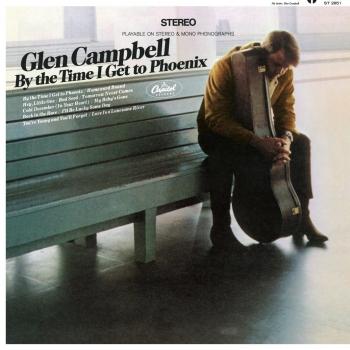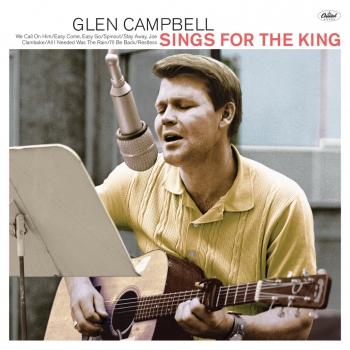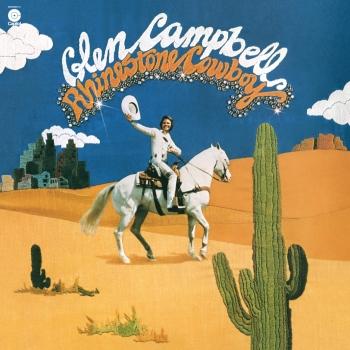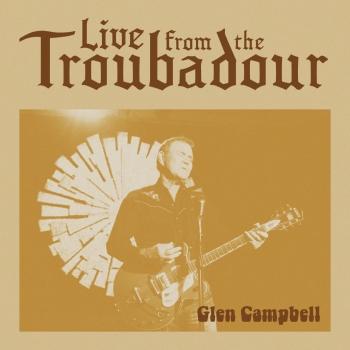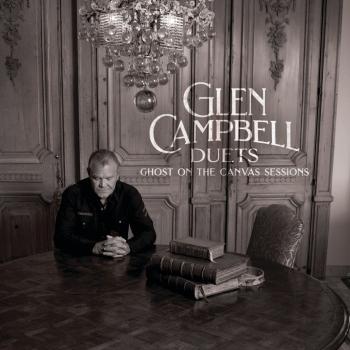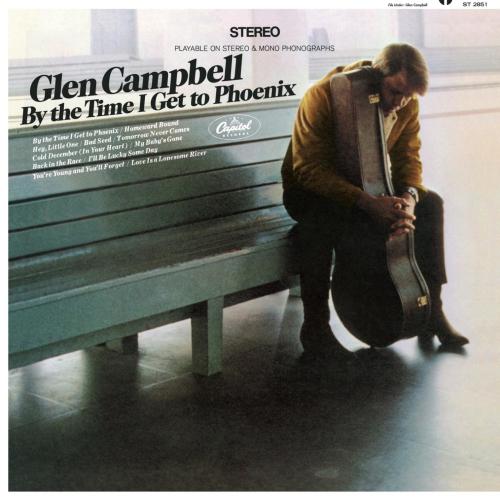
By the Time I Get to Phoenix (Remastered) Glen Campbell
Album Info
Album Veröffentlichung:
1967
HRA-Veröffentlichung:
02.01.2018
Label: Capitol Records Nashville
Genre: Songwriter
Subgenre: Contemporary Folk
Interpret: Glen Campbell
Das Album enthält Albumcover
Entschuldigen Sie bitte!
Sehr geehrter HIGHRESAUDIO Besucher,
leider kann das Album zurzeit aufgrund von Länder- und Lizenzbeschränkungen nicht gekauft werden oder uns liegt der offizielle Veröffentlichungstermin für Ihr Land noch nicht vor. Wir aktualisieren unsere Veröffentlichungstermine ein- bis zweimal die Woche. Bitte schauen Sie ab und zu mal wieder rein.
Wir empfehlen Ihnen das Album auf Ihre Merkliste zu setzen.
Wir bedanken uns für Ihr Verständnis und Ihre Geduld.
Ihr, HIGHRESAUDIO
- 1 By the Time I Get to Phoenix 02:43
- 2 Homeward Bound 02:42
- 3 Tomorrow Never Comes 02:25
- 4 Cold December (In Your Heart) 02:33
- 5 My Baby's Gone 02:55
- 6 Back in the Race 02:02
- 7 Hey Little One 02:32
- 8 Bad Seed 02:24
- 9 I'll Be Lucky Someday 02:27
- 10 You're Young and You'll Forget 02:22
- 11 Love Is a Lonesome River 02:09
Info zu By the Time I Get to Phoenix (Remastered)
Contrary to popular belief, 1967's "By the Time I Get to Phoenix" was not Glen Campbell's first album for Capitol Records; he had released several other albums and singles for the label since 1964, including the lost Brian Wilson treasure "Guess I'm Dumb" in 1966. This album, however, was both his commercial breakthrough and represents the first fruits of his collaboration with Jimmy Webb, the songwriter who would go on to pen most of Campbell's biggest hits.
The title track is the only Webb composition on the record, but the other 10 tracks are equally fine, particularly an excellent, emotional cover of Paul Simon's "Homeward Bound" and a heavily orchestrated but vocally sly take on the Jerry Reed hit "You're Young and You'll Forget." Finally, although Campbell is rightly praised mostly as an interpretive singer, two of the album's finest songs, "Back in the Race" and the placid closer "Love Is A Lonesome River," are Campbell originals, the latter co-written by another member of the Beach Boys' inner circle, Roger Christian.
"Glen Campbell's commercial breakthrough came by way of the title track, which was the direct precursor in production terms to "Wichita Lineman," and by the same writer. The cover of Paul Simon's "Homeward Bound" is sincere if a little perfunctory, but Campbell's rendition of Ernest Tubb's "Tomorrow Never Comes" is a bravura performance, rich and soulful, as well as recalling Rodgers & Hammerstein's "You'll Never Walk Alone" as done by Gerry & the Pacemakers. "Cold December in Your Heart" harks back to Campbell's country-folk material, a piece of midtempo country-pop. Material like that and the similar "Back in the Race," Dorsey Burnette's "Hey Little One," Jerry Reed's "You're Young and You'll Forget," and Bill Anderson's "Bad Seed" hold up better than more pop-focused numbers like "My Baby's Gone," though the string backings on most of these very much date them. The final number here, the touching "Love Is a Lonesome River," makes a brilliant coda. By the Time I Get to Phoenix was reissued in August of 2001 in a newly remastered, upgraded edition, with somewhat crisper sound, as part of Capitol-Nashville's Cornerstones series." (Bruce Eder, AMG)
"The subtle, mournful ballad is one of the most-covered songs of the 20th century. Frank Sinatra called composer Jimmy Webb’s subtle, mournful ballad “By the Time I Get to Phoenix” the “greatest torch song ever written”. Yet when Webb, then a young writer for Motown, presented the tune’s three narrative verses to his bosses, they were puzzled: “Where’s the chorus?”
There was no chorus, although not for lack of Motown trying to wrestle one on to it. The song follows the narrator on a road trip to Oklahoma, as he marks out the miles imagining what “she” is doing as he drives far away from her, for good this time.
After kicking around fruitlessly at Motown, Webb’s song ended up with the singer/producer Johnny Rivers, who recorded it in 1966 on the album Changes, for his own label. Rivers, who still tours today, considered releasing “Phoenix” as a single but instead suggested it to a fellow producer who was working with a young singer/guitarist: Glen Campbell.
Campbell had had a couple of minor solo hits (although one of them, “Gentle on My Mind”, went on to win a Grammy), and had stepped in on tour with the Beach Boys after Brian Wilson’s breakdown. Campbell was part of the legendary Wrecking Crew, top LA session players working on such 1960s-defining hits as “He’s a Rebel” and “California Dreamin’”. He also possessed a faultless five-octave range. Giving the song to Campbell was an inspired suggestion. Within a month of Campbell recording “Phoenix” in 1967, the tune reached number 2 in the country charts and 26 in the pop charts. It became one of the most-covered songs of the 20th century, attracting artists from the Four Tops to Nick Cave and the Bad Seeds.
The song opened a partnership between Webb and Campbell that was to produce, among many, the pop country classics “Galveston” and “Wichita Lineman”. (Webb has been touring with a show called The Glen Campbell Years, a tribute to the singer who is now suffering from advanced dementia.)
Meanwhile some listeners cavilled at the timings ascribed to the “Phoenix” route, even producing maps to show how improbable they were. “Sometimes as a writer you come to a decision like that and you just flip a coin,” the composer responded in the 2011 book Chicken Soup for the Soul: Country Music. “You could try ‘By the Time I get to Flagstaff’, but does it work as well?”
Campbell’s sweet-tenored account of “Phoenix” came in at a radio-friendly less-than three minutes. But just two years later, a monumental 19-minute version emerged on an album from soul singer Isaac Hayes, then a house musician and writer at Memphis label Stax. Hot Buttered Soul became the first album to hit high in four charts: R&B, jazz, pop and easy listening, restoring Stax’s fortunes after the loss of its artist Otis Redding in a plane crash. Hayes audaciously opens with a then unheard-of 10-minute rap, inventing an intense back-story for the “Phoenix” couple. His sensual baritone delivers a cautionary tale for the uxorious: a husband working triple time to please a faithless woman who brags about his stupidity.
As his wronged protagonist packs his car, it’s 3:30 in the morning and Hayes is yet to go anywhere near the song’s melody. By the time he does, the length of the recording — there are only four tracks on the album — had overturned the formula of hit-singles-plus-filler that governed the industry’s treatment of black albums. Hayes’s million-selling refashioning of a country pop hit opened a radical space into which Marvin Gaye, Curtis Mayfield and others soon stepped.
Yet Hayes said that his rapped intro only came about when he found himself performing a first attempt at “Phoenix” in front of a chattering club audience. “I figured I’d better do something,” he told the writer Gerri Hirshey. “I knew they were going to think I was crazy to be doing a song by a white pop singer, so I figured I’d explain. And I started talking . . .” (The Financial Times)
Glen Campbell, vocals, guitar
Digitally remastered by Bob Norberg & Rob Christie at Capitol Mastering
Glen Campbell
From the Wrecking Crew to “Rhinestone Cowboy.” From “By the Time I Get to Phoenix” to “A Better Place.”
Twenty-one Top 40 hits with two hitting No. 1. Six Top 20 albums including chart-topper Wichita Lineman. Twenty-seven country Top 10 singles — spanning 22 years — and nine country No. 1 albums.
Five Grammy Awards, three Grammy Hall of Fame honors and a Grammy Lifetime Achievement Award, seven Academy of Country Music awards and a 1998 Pioneer Award recognition, three American Music Awards, two Country Music Association Awards and a 2005 Country Music Hall of Fame induction, three Gospel Music Association Dove Awards.
Not to mention hosting of one of the era’s most-beloved variety shows, co-star of the original “True Grit” (at the behest of star John Wayne, no less, earning a Golden Globe “most promising newcomer” nomination) and voice of a cherished animated rooster. And today Alan Jackson, Keith Urban, Jakob Dylan and many others cite him as a primary influence and inspiration.
Glen Campbell’s musical and entertainment lifetime, covering over five decades, is unmatched for its prolific breadth, popular appeal – and flat-out musical accomplishment and achievement. His biggest run of hits (“Gentle on My Mind,” “By the Time I Get to Phoenix,” “Wichita Lineman,” “Galveston,” “Rhinestone Cowboy” and “Southern Nights” just to name a handful) put him in the pop elite of the late-‘60s and early-‘70s, erasing the line between pop and country and helping pave the way for generations of others. You could well call him the first countrypolitan star, though the sharecropper’s son from Delight, Arkansas never lost any of the pure country in his soul.
But even at his popular peak, few were aware of the full extents of his credentials as a first-call session guitarist whose picking helped shape Phil Spector’s famed “Wall of Sound” and the Beach Boys’s most creative works (the latter for whom he also became a touring member for a stretch when Brian Wilson first retired from the road in 1964). That’s him creating indelible guitar parts on the Beach Boys’ landmark Pet Sounds album,” Frank Sinatra’s “Strangers in the Night,” the Righteous Brothers’ “You’ve Lost That Lovin’ Feeling” and the Monkees’ “I’m a Believer,” not to mention hits by Elvis Presley, Bobby Darin, Lou Rawls, Ricky Nelson, Merle Haggard, Bobby Vee. And yeah, you can see him backing various artists with the Wrecking Crew as the house band on the legendary “T.A.M.I. Show.”
This background made his TV show, The Glen Campbell Goodtime Hour, a destination for the top artists of the era – but he also used the setting to show off his own skills and those of some lesser-known friends (John Hartford, Doug Dillard) in the regular “Pickin’ Pit” segment with friendly folk-country cutting contests between the players. It was an eye-opening look into American roots music for the mainstream. The combination of talents and personality that made him a TV star enabled him to transcend eras, remaining a hit-maker across decades as well as across genres.
Well-documented troubles and struggles along the way at times took him on less pleasant paths. But through family and faith he overcame them, not just surviving but thriving. And not only has he remained a top touring artist through the years – with sons Cal and Shannon and daughter Ashley becoming key members of his band – but has found fresh approaches and material as well. Working with producer Julian Raymond, in 2008 he released the pointedly titled Meet Glen Campbell, an album of personalized interpretations of songs originated by such vital artists as U2, Jackson Browne, Green Day, Tom Petty, the Foo Fighters and even the Velvet Underground, with musical support from members of Jellyfish, Jane’s Addiction and Cheap Trick’s Robin Zander and Rick Nielsen.
That was followed by 2011’s Ghost on the Canvas, a moving, engaging and inspirational song cycle that traces the arc of his remarkable life, love and faith. With songs crafted by Campbell and Raymond (once again producing) joined by contributions from acolytes Jakob Dylan, Paul Westerberg and Teddy Thompson and guest appearances by such admirers as Smashing Pumpkins’ Billy Corgan, Brian Setzer and members of the Dandy Warhols, the album at once renewed and revitalized the spirit of classic Campbell albums and stood tall alongside them. Shortly after he recorded the album, Glen was diagnosed with Alzheimer’s disease. Undeterred, he embarked on a series of live dates that he dubbed “The Glen Campbell Goodbye Tour.”
USA Today hailed Ghost on the Canvas as “a museum-quality masterpiece,” while Rolling Stone noted: “The years have added an edge to his singing.” He was honored with a star-studded tribute at the Country Music Awards in 2011 and a Lifetime Achievement Award at the Grammy Awards in 2012.
During the Ghost sessions, Campbell took a fresh look at his older material and – for the first time – laid down new vocals for many of his classic, career-defining hits. Producers Dave Kaplan and Dave Darling later took Glen’s vocals and reinterpreted the songs to convey an intimacy that is at once chilling, uplifting, haunting and spine-tingling all at the same time, all of this much to Campbell’s delight. “When Glen heard the results of what Dave and Dave did in reinterpreting these songs, he lit up and was smiling from ear to ear. And I was too.” Kim Campbell says. “We heard these songs and Glen’s voice in a whole new way and absolutely love the results.”
Demonstrating once again that his characteristic warmth and sense of humor are intact, Campbell titled the resulting album See You There, an expression that’s been a trademark of his for decades, but takes on an added poignancy at this stage of his life and career. See You There was released on August 13th, 2013.
Dieses Album enthält kein Booklet












